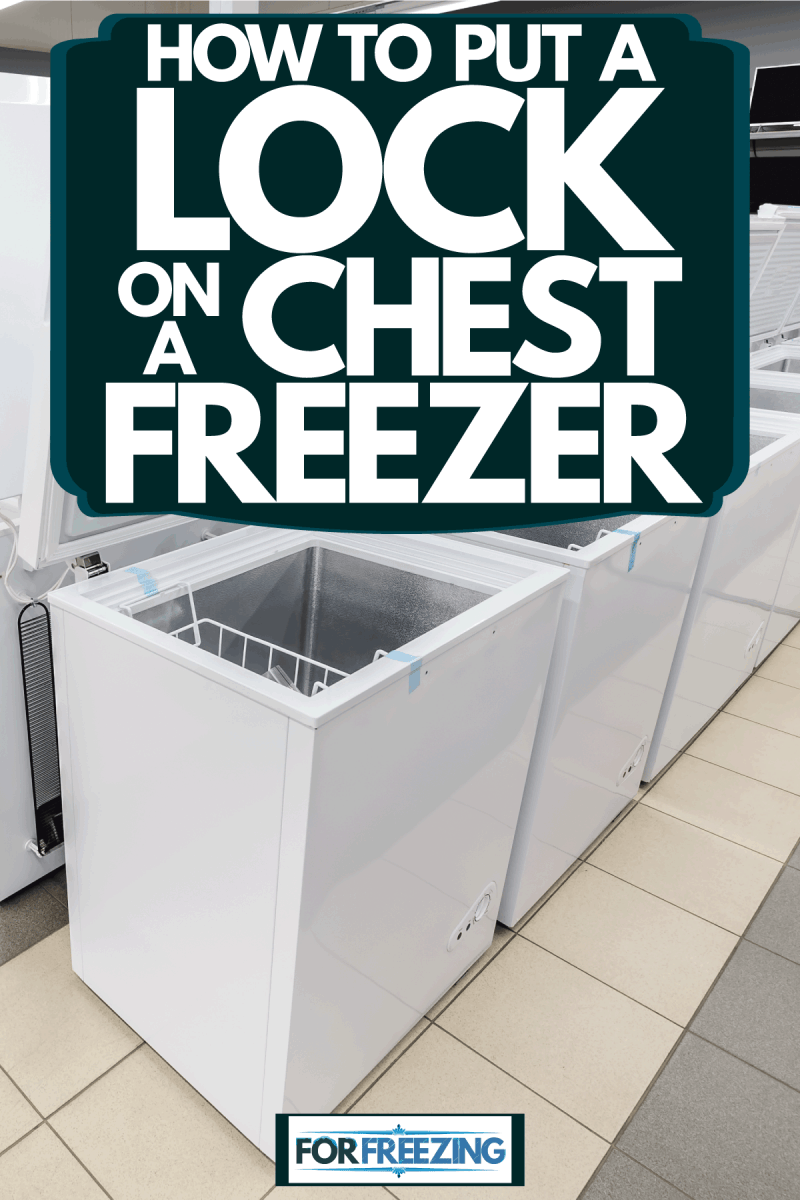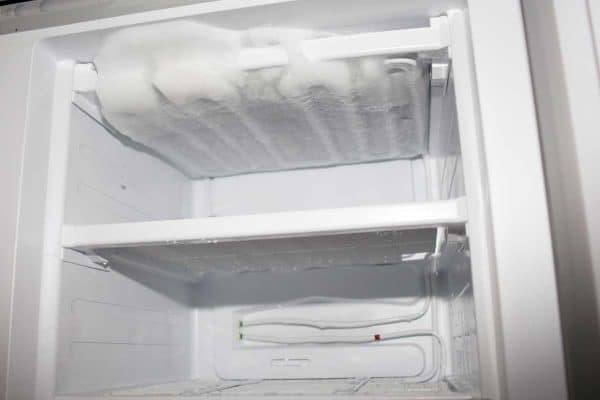Putting food in an unguarded freezer can invite thieves in certain situations. So installing a lock on a chest freezer is a reasonably inexpensive yet effective method of keeping frozen food away from prying hands. However, how can you put a lock on a chest freezer? If you don’t know how to accomplish this goal, no need to worry because we have pulled together the steps for you.
Follow these steps to put a new lock on a chest freezer:
- Remove dirt, grease, and grime on the chest freezer’s surface.
- Place and hold a single-clasp hasp in the desired location while marking the area with a pen or pencil.
- Screw the hasp into place with a drill and install the loop.
- Fold the other end of the hasp over the loop, then attach and close the lock.
The entire process is reasonably straightforward. But continue reading to learn the details about installing a lock on your chest freezer so you don’t commit mistakes. Furthermore, we answered some questions about keys and locks on chest freezers in the next sections.
NOTE: WE MAY GET A COMMISSION IF YOU DECIDE TO MAKE A PURCHASE THROUGH THESE LINKS. THERE'S ADDITIONAL NO COST TO YOU. CHECK THE BOTTOM OF THE PAGE FOR MORE INFORMATION.

Can You Screw Into A Freezer?
While you can drill and screw into a freezer to put a new lock, it's best to take this precaution: Drilling holes and installing screws into the appliance without checking on the location can damage or even destroy the appliance. It's because many freezers have wires or refrigerant lines underneath their surfaces.
Drill a small pilot hole before using larger bits to enlarge it gradually. Don't ever attempt to drill new holes into your freezer if you're unsure about the location.
How Do You Lock a Chest Freezer Door?

Before proceeding with this project, make sure to find a suitable place for the lock. As we have discussed above, avoid ‘happy drilling,’ where you pick a random spot on your freezer’s surface for the lock. Otherwise, you can ruin the appliance's thermal insulation by creating a dew point. Always check with your freezer’s manual first to find out the optimal location for the new lock.
Installing a chest freezer lock
Once you found the right spot, follow these steps to put the new lock on the chest freezer:
1. Clean the chest freezer’s Surface
Dust, grease, grime, and small debris can get in the way of the lock’s installation. Grab a damp cloth and wipe the appliance’s surface with it. Don’t forget to wipe the area where your lock is going to go. You can also use a reliable degreaser to remove stubborn grease. Then, wipe the surface dry.
2. Verify and Mark the Location
Additionally, and as previously mentioned, the exact location of the installation is important to avoid ruining your chest freezer. Verify the location of the hasp and don’t lose that area by marking it with a pen or pencil. Make sure to highlight the screw holes where the hasp will go.
Take note that the hasp’s dangling piece should be hanging at the side of the appliance. The other parts of the hasp should rest over the loop securely after finishing the installation.
3. Screw in the Hasp
Use an electric drill to screw the single-clasp hasp into the desired location. The screws needed for the installation should be in the package that comes with the hasp. Otherwise, you need to use the right screws to avoid loosening or overtightening the hasp.
4. Fold the Loop and Lock the Freezer
Screw the hasp’s loop into place. Then, fold the other end down and over the loop. At this point, you can now install and close the padlock to secure the chest freezer. Additionally, keep the key in a safe place.
Remember, only use a secure lock for your chest freezer. Otherwise, you increase the risk of food spoiling when the freezer door is left open for a long time. For more information about that particular topic, check out our post: How Long Can You Leave the Freezer Door Open?
Check out this reset hasp latch on Amazon.
How Do You Lock A Small Chest Freezer?
Some chest freezer models, particularly small variants, already have built-in locks. The process should only require you to push and twist the key into the lock to secure the appliance. But make sure to set the desired temperature in the freezer beforehand. Also, don’t slam the appliance’s lid to avoid harming the seal.
How to Replace Locks on A Freezer Door
Certain freezer door locks can rust over time. Additionally, old locks may not function as efficiently as their newer counterparts. Replacing the locks on your freezer door can be the best solution for these concerns.
Take note that the process of replacing your freezer door lock may not require you to use special equipment. With that in mind, here are the steps to replace the lock on the appliance’s door:
- Unplug or cut the power to your chest freezer to be safe.
- Remove the screws from the old lock.
- Install the new lock in the same location using a screwdriver and the screws included in the package.
- Plug the appliance again.
- Lock and unlock the new lock several times to test it out.
How Do You Use A Freezer Key?
Generally, a freezer key works like relatively any other physical key with a pin-and-tumbler design. In other words, these locks require a unique key to unlock spring-loaded pins in the lock. Once you twist the key, the springs release the pins, unlocking the lock.
Some freezer owners may want to use combination locks instead of pin-and-tumbler models. It’s because the former option can be more secure than the latter.
A classic combination padlock has a wheel pack with numbers that can range from 1 to 10 or 0 to 99. Turning the dial will rotate a spindle in the lock, which, in turn, rotates a drive cam. Then, an attached drive pin will make contact with the registered numbers. The lock will release once you input the correct numbers in the precise order.
Some combination lock models will even need users to use a key after inputting the correct series of numbers. These options tend to be even more secure than standard combination padlocks on the market.
On the other hand, some freezers will already come with locks with self-ejecting keys. Freezer manufacturers install these locking mechanisms to help prevent issues like the key getting jammed in the lock.
Moving forward, to use a self-ejecting key, insert it into the lock and turn it to the left. The key should pop out almost immediately after twisting to prevent it from getting stuck in the lock. This mechanism can also help users remember to put away the key instead of leaving it in the lock, which would otherwise invite thieves.
If you're wondering why some freezers already have built-in locks, check out our post on this very topic: Why Do Some Freezers Have Locks?
Check out the Master Lock 1500T combination padlock on Amazon.
Final Words
You can install a lock on a chest freezer by drilling and screwing holes into the appliance. Make sure to check the instruction manual to know where to drill and screw.
Finding the correct location for the new lock is important to avoid damaging or destroying the appliance. Additionally, you have the option to use other locks, such as combination locks, if you find those other options as more secure selections than standard pin-and-tumbler deadbolts.





![Woman hand open plastic white container drawer in new refrigerator. How To Put A Freezer Drawer Back In [Inc. For Specific Brands]](https://forfreezing.com/wp-content/uploads/2021/09/Woman-hand-open-plastic-white-container-drawer-in-new-refrigerator.-How-To-Put-A-Freezer-Drawer-Back-In-Inc.-For-Specific-Brands-600x400.png)